An interruption to the upwards trend was expected to come before 3,174.78. Today the AD line and VIX may indicate whether this interruption has arrived early or not.
Summary: For the short term, some bearish divergence between price and the AD line suggests minor 4 may have arrived today, but a new all time high from On Balance Volume is more bullish and suggests the target at 3,179 may yet be met. If minor wave 4 has arrived today, then it may be expected to be very shallow. A target for support is about 3,040.
Three large pullbacks or consolidations during the next few months are expected: for minor wave 4, then intermediate (4), and then primary 4. Prior to each of these large corrections beginning, some weakness may begin to be evident.
The biggest picture, Grand Super Cycle analysis, is here.
Monthly charts were last published here, with video here. There are two further alternate monthly charts here, with video here.
ELLIOTT WAVE COUNTS
The two weekly Elliott wave counts below will be labelled First and Second. They may be about of even probability. When the fifth wave currently unfolding on weekly charts may be complete, then these two wave counts will diverge on the severity of the expected following bear market. To see an illustration of this future divergence monthly charts should be viewed.
FIRST WAVE COUNT
WEEKLY CHART
The basic Elliott wave structure consists of a five wave structure up followed by a three wave structure down (for a bull market). This wave count sees the bull market beginning in March 2009 as an incomplete five wave impulse and now within the last fifth wave, which is labelled cycle wave V. This impulse is best viewed on monthly charts. The weekly chart focusses on the end of it.
Elliott wave is fractal. This fifth wave labelled cycle wave V may end a larger fifth wave labelled Super Cycle wave (V), which may end a larger first wave labelled Grand Super Cycle wave I.
The teal Elliott channel is drawn using Elliott’s first technique about the impulse of Super Cycle wave (V). Draw the first trend line from the end of cycle wave I (off to the left of the chart, the weekly candlestick beginning 30th November 2014) to the end of cycle wave III, then place a parallel copy on the end of cycle wave II. This channel perfectly shows where cycle wave IV ended at support. The strongest portion of cycle wave III, the end of primary wave 3, overshoots the upper edge of the channel. This is a typical look for a third wave and suggests the channel is drawn correctly and the way the impulse is counted is correct.
Within Super Cycle wave (V), cycle wave III is shorter than cycle wave I. A core Elliott wave rule states that a third wave may never be the shortest. For this rule to be met in this instance, cycle wave V may not be longer in length than cycle wave III. This limit is at 3,477.39.
Cycle wave V may subdivide either as an impulse or an ending diagonal. Impulses are much more common. An alternate wave count, which looked at the possibility of a diagonal unfolding, has been invalidated with a new all time high.
The daily chart below will focus on movement from the end of intermediate wave (1) within primary wave 3.
In historic analysis, two further monthly charts have been published that do not have a limit to upwards movement and are more bullish than this wave count. Members are encouraged to consider those possibilities (links below summary) alongside the wave counts presented on a daily and weekly basis.
Within cycle wave V, primary waves 1 and 2 may be complete. Within primary wave 3, intermediate waves (1) and (2) may be complete. Within the middle of intermediate wave (3), no second wave correction may move beyond its start below 2,855.96.
DAILY CHART
All of primary wave 3, intermediate wave (3) and minor wave 3 may only subdivide as impulses.
Minor wave 3 may be underway and may have passed through its middle. Within minor wave 3, minute wave iv may not move into minute wave i price territory below 3,003.28.
Intermediate wave (3) must move far enough above the end of intermediate wave (1) to then allow intermediate wave (4) to unfold and remain above intermediate wave (1) price territory.
The target for intermediate wave (3) fits with a target calculated for minor wave 3.
It is possible today that a multi-week pullback or consolidation for minor wave 4 may begin. Minor wave 4 must remain above minor wave 1 price territory at 3,021.99. Minor wave 2 was a sharp deep pullback, so minor wave 4 may be expected to be a shallow sideways consolidation to exhibit alternation. Minor wave 2 lasted 2 weeks, so minor wave 4 may be about the same duration to have good proportion.
If labelling within minor wave 3 is correct, then minute wave iii is shorter than minute wave i. Minute wave iii may not be the shortest actionary wave within the impulse of minor wave 3. If minute wave v is over, then it is shorter than minute wave iii and all rules are met.
HOURLY CHART
There are multiple ways now to label upwards movement from the end of minor wave 2.
Each of the currently unfolding third waves of minute wave iii, minor wave 3, intermediate wave (3) and primary wave 3 may only subdivide as simple impulses.
It is possible today that minor wave 3 could be over. There is no Fibonacci ratio between minor waves 3 and 1, and minor wave 3 would be longer than minor wave 1.
Within minor wave 3, minute wave iii is shorter than minute wave i. This indicates it is very unlikely that minute wave v would be extended.
Minor wave 2 was a deep 0.83 zigzag lasting 10 sessions. Minor wave 4 may be very shallow and may be a sideways time consuming structure such as a combination, triangle or flat.
ALTERNATE HOURLY CHART
There are multiple ways to label upwards movement from the end of minor wave 2.
It is possible that minor wave 3 is incomplete. Within it, minute wave iii may be incomplete.
Within minute wave iii, minuette wave (iv) may complete tomorrow as a very shallow quick correction. Thereafter, upwards movement may continue towards the original target for minor wave 3.
While price remains within the channel, this wave count will remain viable and should be considered seriously. The main reason today why it is an alternate is bearish divergence between price and the AD line.
SECOND WAVE COUNT
WEEKLY CHART
This weekly chart is almost identical to the first weekly chart, with the sole exception being the degree of labelling.
This weekly chart moves the degree of labelling for the impulse beginning in March 2009 all down one degree. This difference is best viewed on monthly charts.
The impulse is still viewed as nearing an end; a fifth wave is still seen as needing to complete higher. This wave count labels it primary wave 5.
Primary wave 5 may be subdividing as either an impulse, in the same way that cycle wave V is seen for the first weekly chart.
TECHNICAL ANALYSIS
MONTHLY CHART
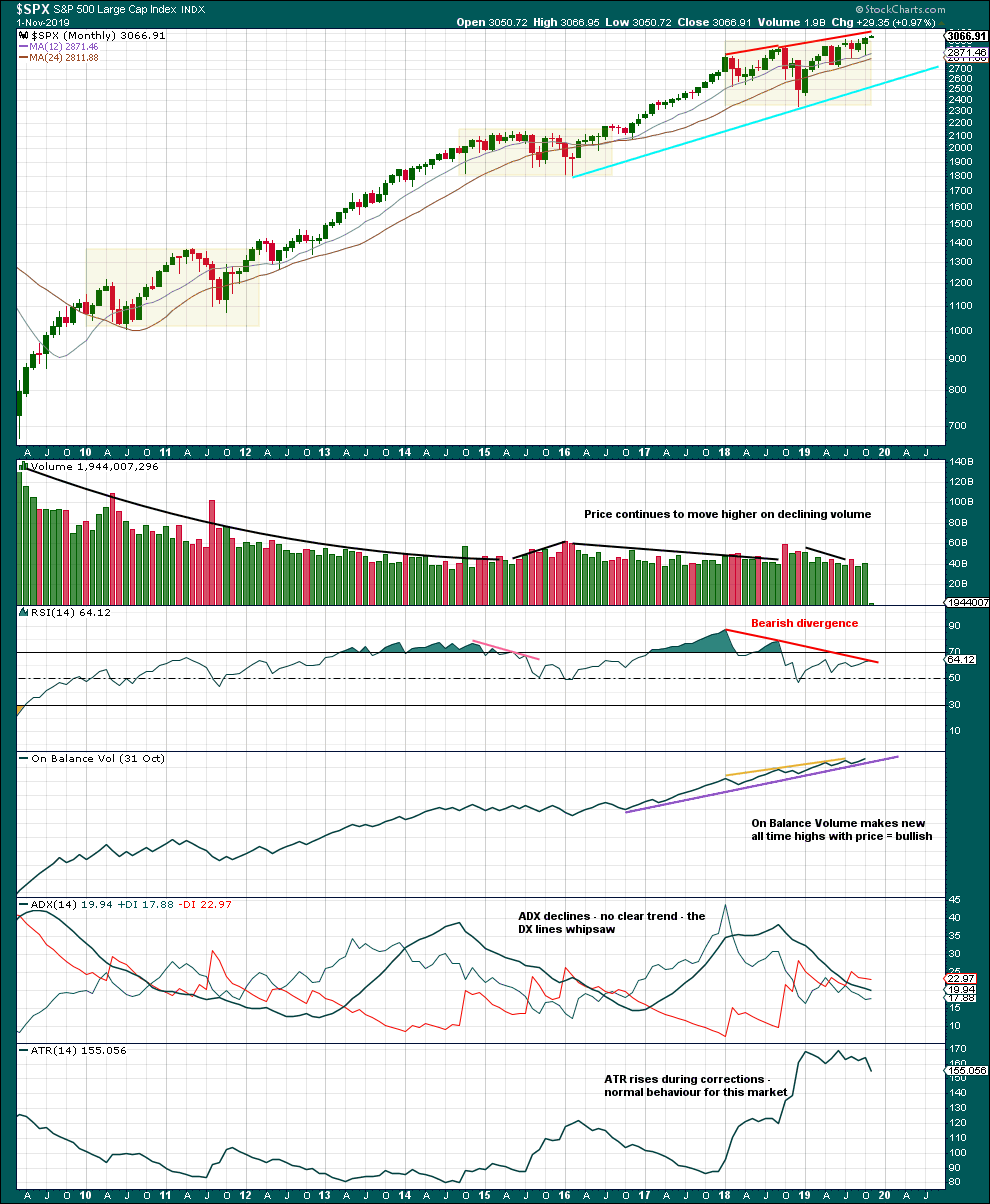
Click chart to enlarge. Chart courtesy of StockCharts.com.
This monthly chart shows the entire bull market since its inception in March 2009. Within this bull market, there are so far three large consolidation boxes highlighted. A basic technical analysis concept is the longer price consolidates within a zone, the longer and further price may travel after a breakout. Price can back test support at prior resistance, and sometimes may re-enter the consolidation zone, before moving up and away.
Currently, price may have last week broken out of a large consolidation. It would be reasonable to now expect upwards movement for a reasonable amount of time after this breakout. It is also possible that pullbacks may re-enter the prior consolidation zone which had resistance about 3,027.
Bearish divergence between price and RSI may develop further before the bull market ends. Occasionally divergence can disappear, but for now it is valid. Given the stage that the Elliott wave count is in with a fifth wave unfolding, some developing weakness at this time frame should be expected.
Note that while On Balance Volume exhibits small divergence with price at lower time frames, it does not at the monthly chart level.
WEEKLY CHART
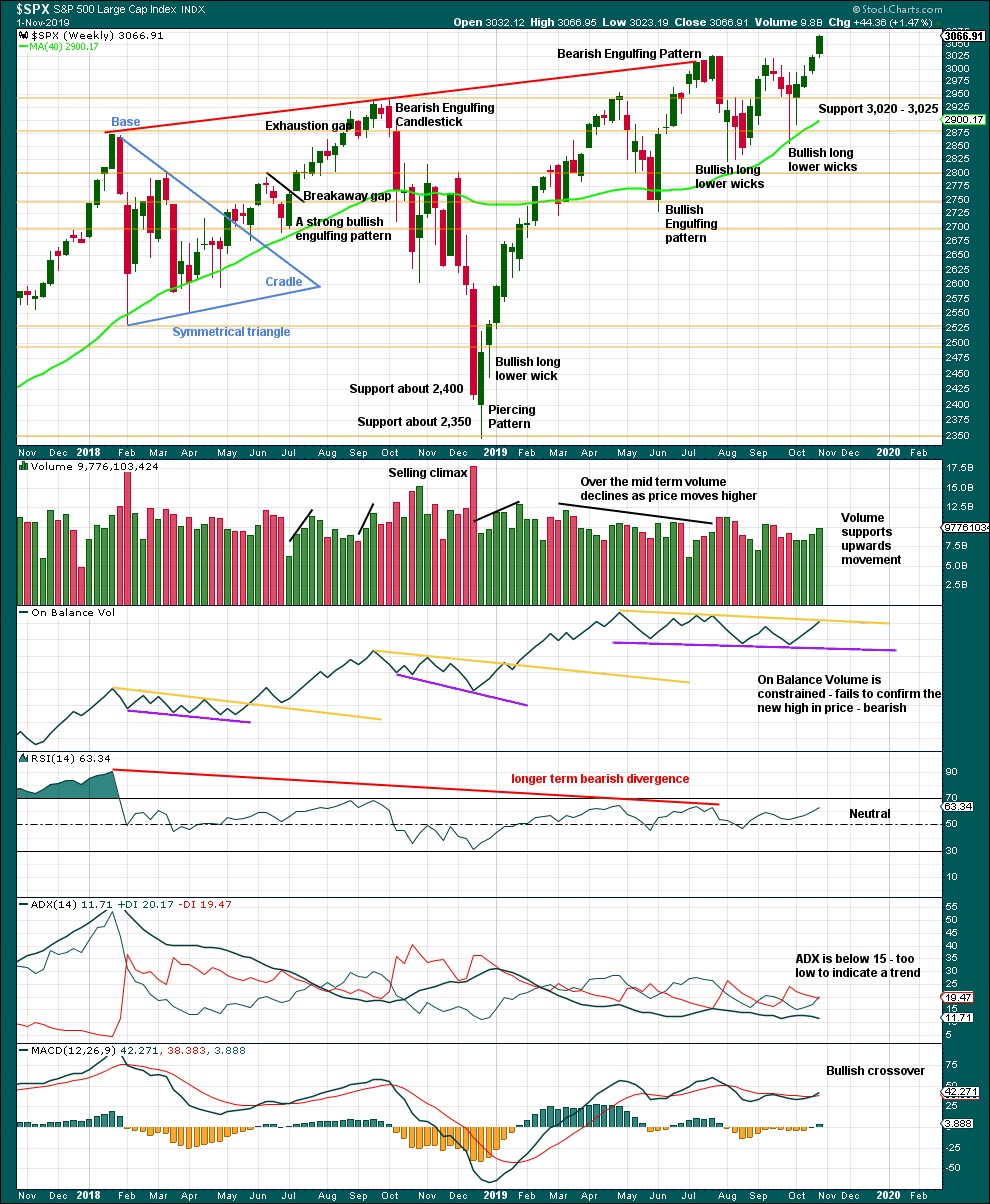
Click chart to enlarge. Chart courtesy of StockCharts.com.
Last week sees a breakout above resistance.
Some developing bearishness in On Balance Volume last week with divergence and resistance suggests a pullback may develop sooner rather than later here.
However, it is very clear that the S&P is in an upwards trend and the bull market is continuing. Price does not move in straight lines; there will be pullbacks and consolidations along the way.
Now that resistance has been overcome and a new all time high is seen, expect a possible release of energy and any surprises should be to the upside. Corrections are normal and to be expected; they may be more short term in nature at this stage.
DAILY CHART
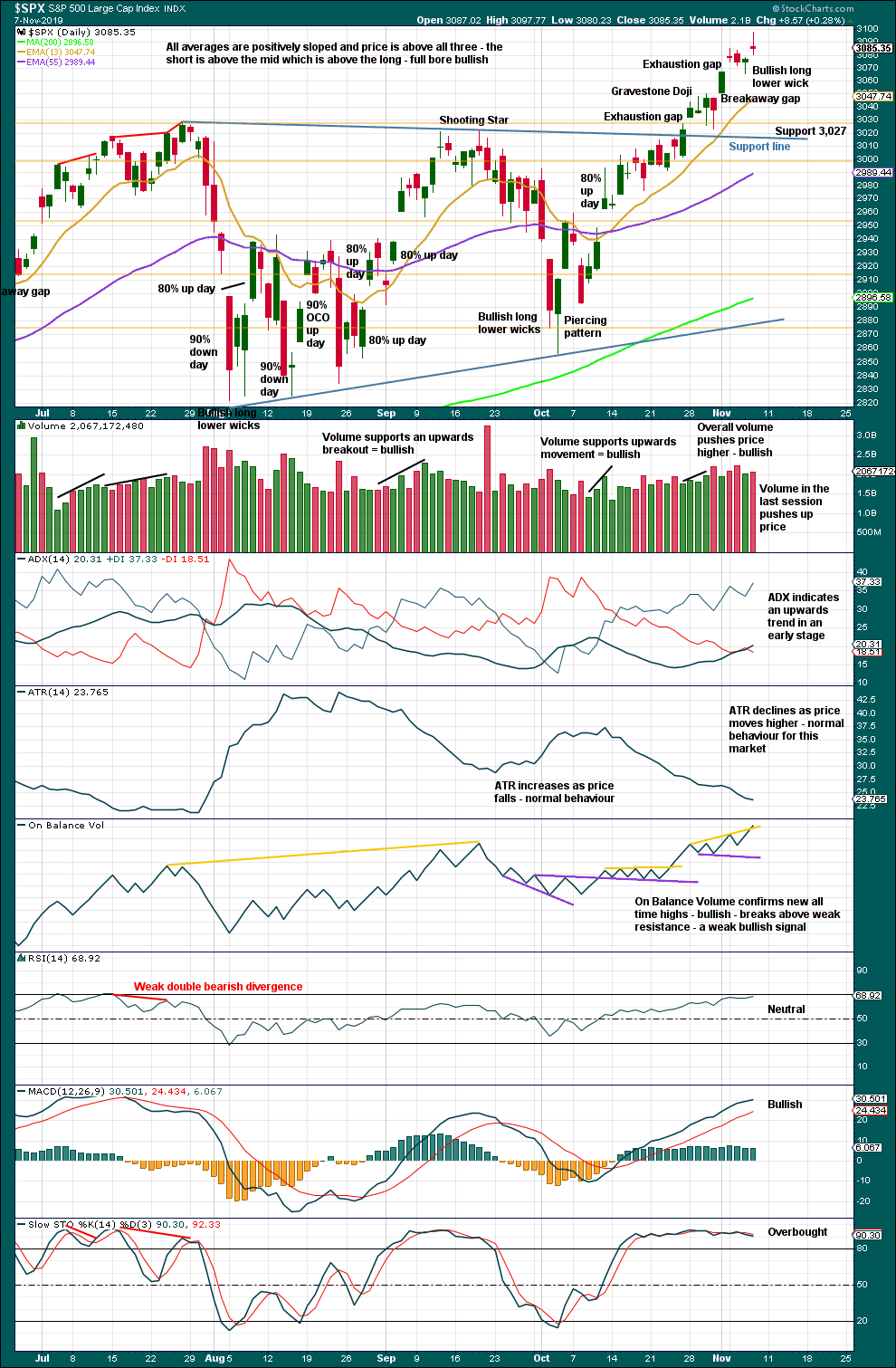
Click chart to enlarge. Chart courtesy of StockCharts.com.
On its own, today’s Doji candlestick is not a reversal pattern; but if tomorrow moves price lower, then an Evening Doji Star may be printed.
There is an upwards trend in place. There will be corrections along the way. On Balance Volume today confirms the new all time high in price. Overall, this chart offers more support to the alternate hourly wave count than the main hourly wave count today.
BREADTH – AD LINE
WEEKLY CHART
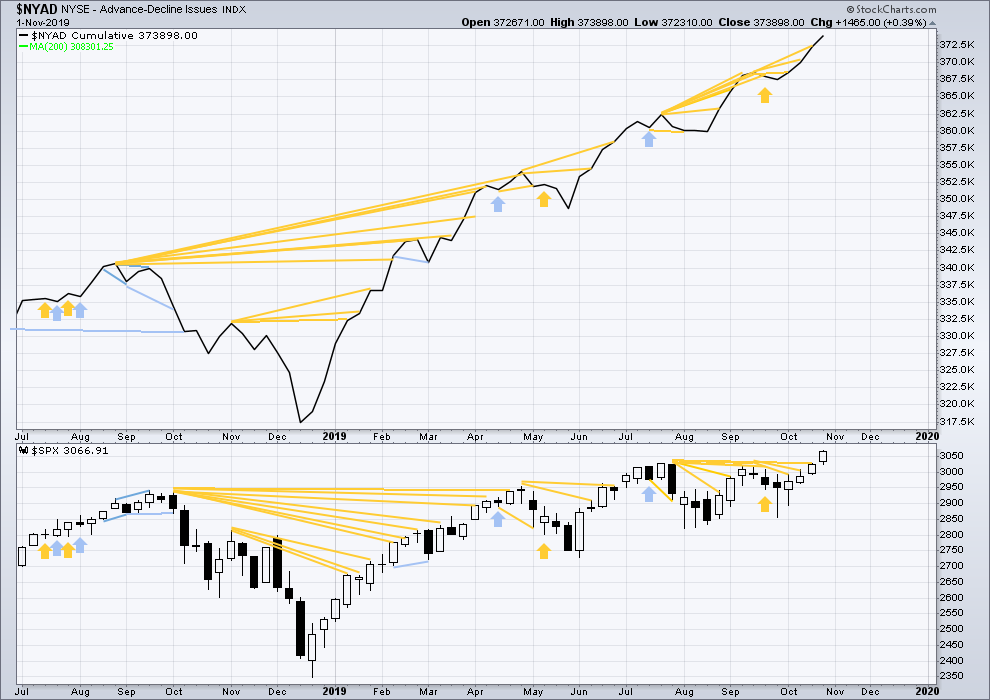
Click chart to enlarge. Chart courtesy of StockCharts.com. So that colour blind members are included, bearish signals
will be noted with blue and bullish signals with yellow.
Bear markets from the Great Depression and onwards have been preceded by an average minimum of 4 months divergence between price and the AD line with only two exceptions in 1946 and 1976. With the AD line making new all time highs continuing this week, the end of this bull market and the start of a new bear market is very likely a minimum of 4 months away, which is beginning March 2020.
In all bear markets in the last 90 years there is some positive correlation (0.6022) between the length of bearish divergence and the depth of the following bear market. No to little divergence is correlated with more shallow bear markets. Longer divergence is correlated with deeper bear markets.
If a bear market does develop here, it comes after no bearish divergence. It would therefore more likely be shallow.
Last week all of small, mid and large caps have made new swing highs above the prior swing high on the 13th of September, but only large caps have made new all time highs. This upwards movement appears to be mostly driven by large caps, which is a feature of aged bull markets. This bull market at over 10 years duration certainly fits the definition of aged.
Mid and small caps have not yet made new all time highs.
DAILY CHART
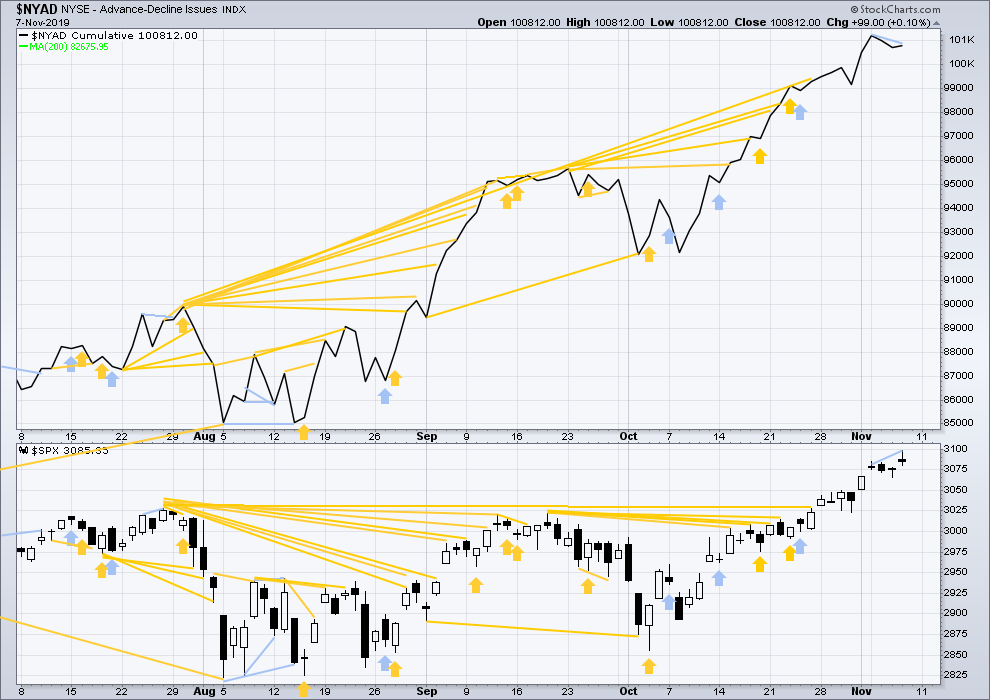
Click chart to enlarge. Chart courtesy of StockCharts.com. So that colour blind members are included, bearish signals
will be noted with blue and bullish signals with yellow.
Breadth should be read as a leading indicator.
Today price and the AD line have moved higher, but price has made a new all time high while the AD line has not. This divergence is bearish for the very short term and supports the main hourly Elliott wave count.
VOLATILITY – INVERTED VIX CHART
WEEKLY CHART
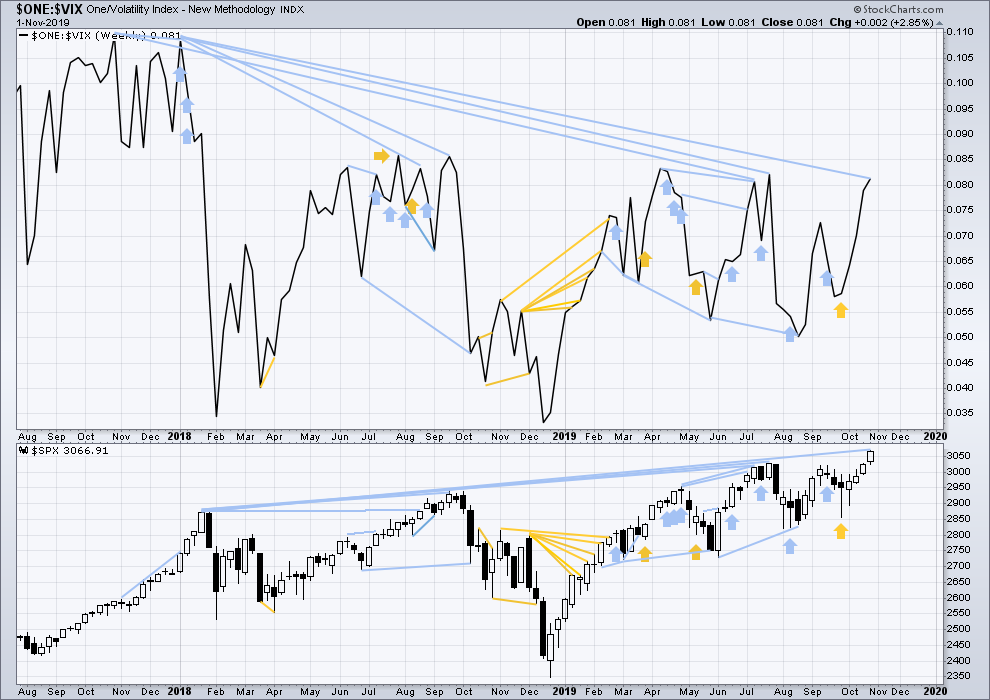
Click chart to enlarge. Chart courtesy of StockCharts.com. So that colour blind members are included, bearish signals
will be noted with blue and bullish signals with yellow.
The all time high for inverted VIX (which is the same as the low for VIX) was on 30th October 2017. There is now over two years of bearish divergence between price and inverted VIX.
The rise in price is not coming with a normal corresponding decline in VIX; VIX remains elevated. This long-term divergence is bearish and may yet develop further as the bull market matures.
This divergence may be an early warning, a part of the process of a top developing that may take years. It may is clearly not useful in timing a trend change from bull to a fully fledged bear market.
Last week both price and inverted VIX have moved higher. Price has made new short-term swing highs, but inverted VIX has not. This divergence is slight and short term, and it adds to the longer term bearish divergence.
DAILY CHART
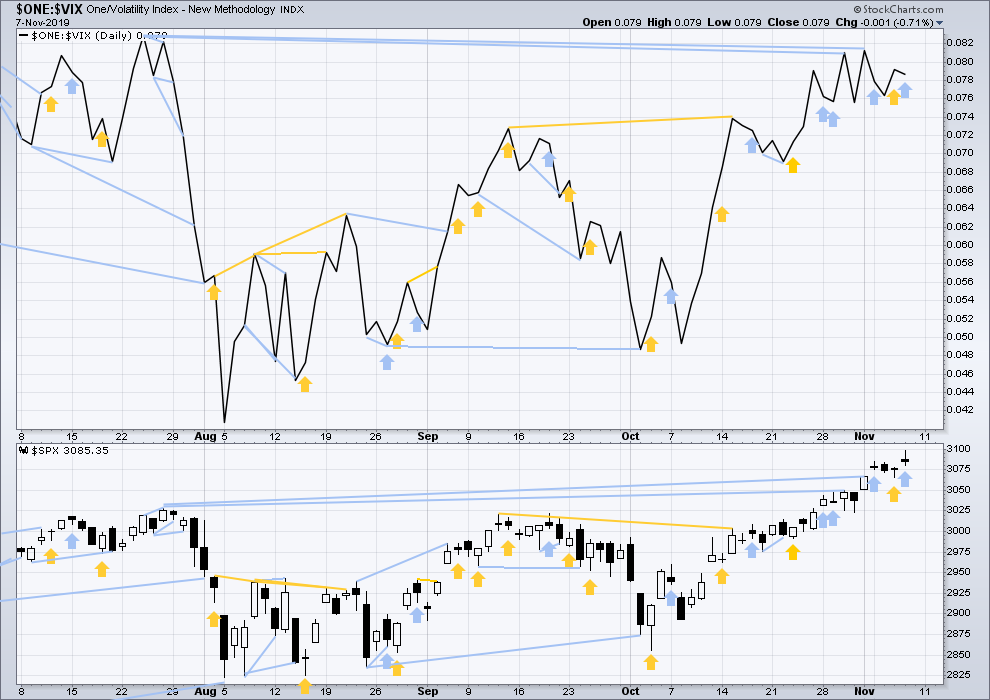
Click chart to enlarge. Chart courtesy of StockCharts.com. So that colour blind members are included, bearish signals
will be noted with blue and bullish signals with yellow.
Today price has moved higher, but inverted VIX has moved lower. This divergence is bearish and confirms a bearish signal today from the AD line, so it shall be given a little weight.
DOW THEORY
Dow Theory confirmed a bear market in December 2018. This does not necessarily mean a bear market at Grand Super Cycle degree though; Dow Theory makes no comment on Elliott wave counts. On the 25th of August 2015 Dow Theory also confirmed a bear market. The Elliott wave count sees that as part of cycle wave II. After Dow Theory confirmation of a bear market in August 2015, price went on to make new all time highs and the bull market continued.
DJIA: 23,344.52 – a close on the 19th of December at 23,284.97 confirms a bear market.
DJT: 9,806.79 – price has closed below this point on the 13th of December.
S&P500: 2,532.69 – a close on the 19th of December at 2,506.96 provides support to a bear market conclusion.
Nasdaq: 6,630.67 – a close on the 19th of December at 6,618.86 provides support to a bear market conclusion.
With all the indices having moved higher following a Dow Theory bear market confirmation, Dow Theory would confirm a bull market if the following highs are made:
DJIA: 26,951.81 – a close above this point has been made on the 3rd of July 2019.
DJT: 11,623.58 – to date DJT has failed to confirm an ongoing bull market.
S&P500: 2,940.91 – a close above this point was made on the 29th of April 2019.
Nasdaq: 8,133.30 – a close above this point was made on the 26th of April 2019.
Published @ 07:45 p.m. EST.
—
Careful risk management protects your trading account(s).
Follow my two Golden Rules:
1. Always trade with stops.
2. Risk only 1-5% of equity on any one trade.
—
New updates to this analysis are in bold.

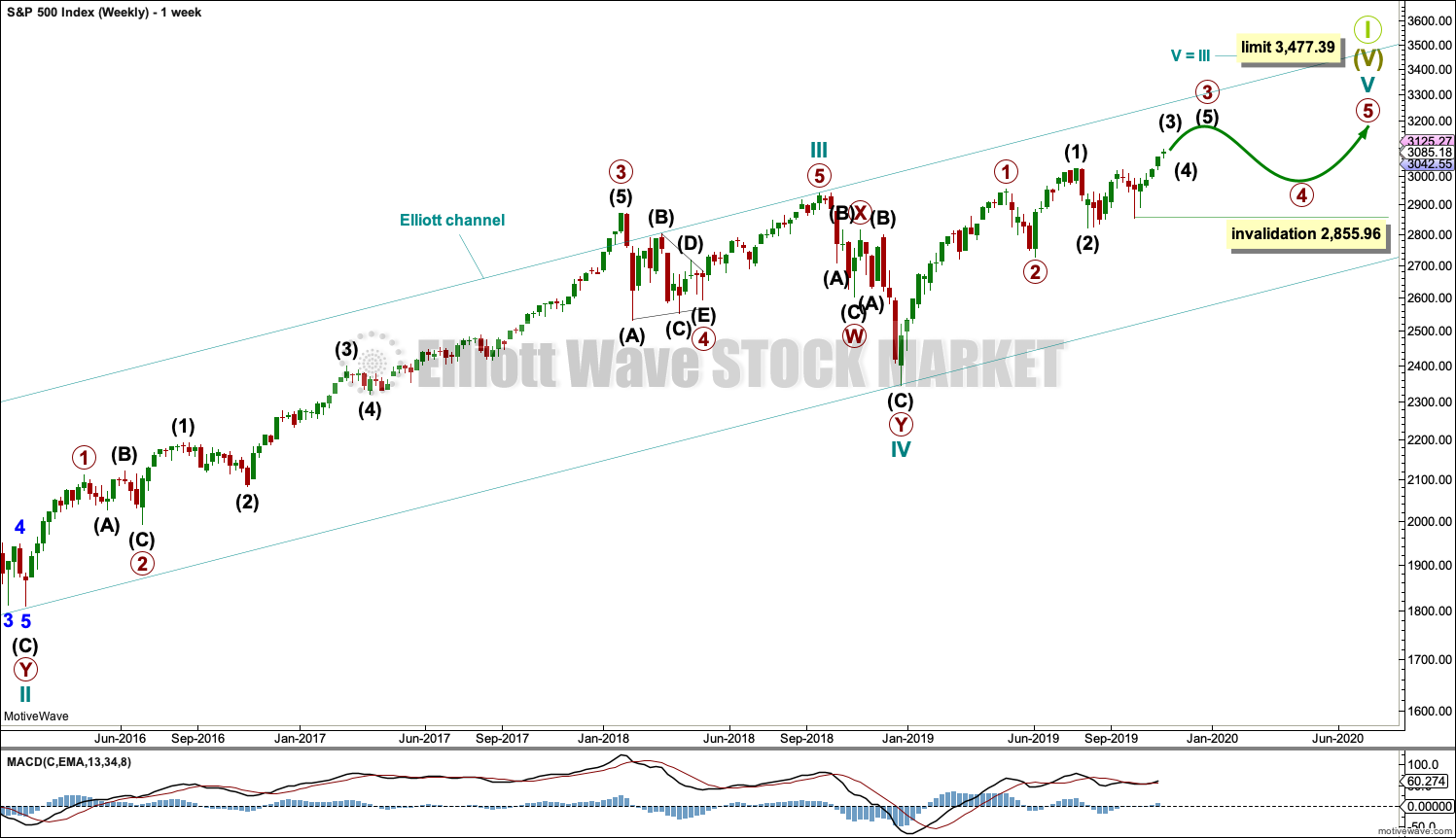
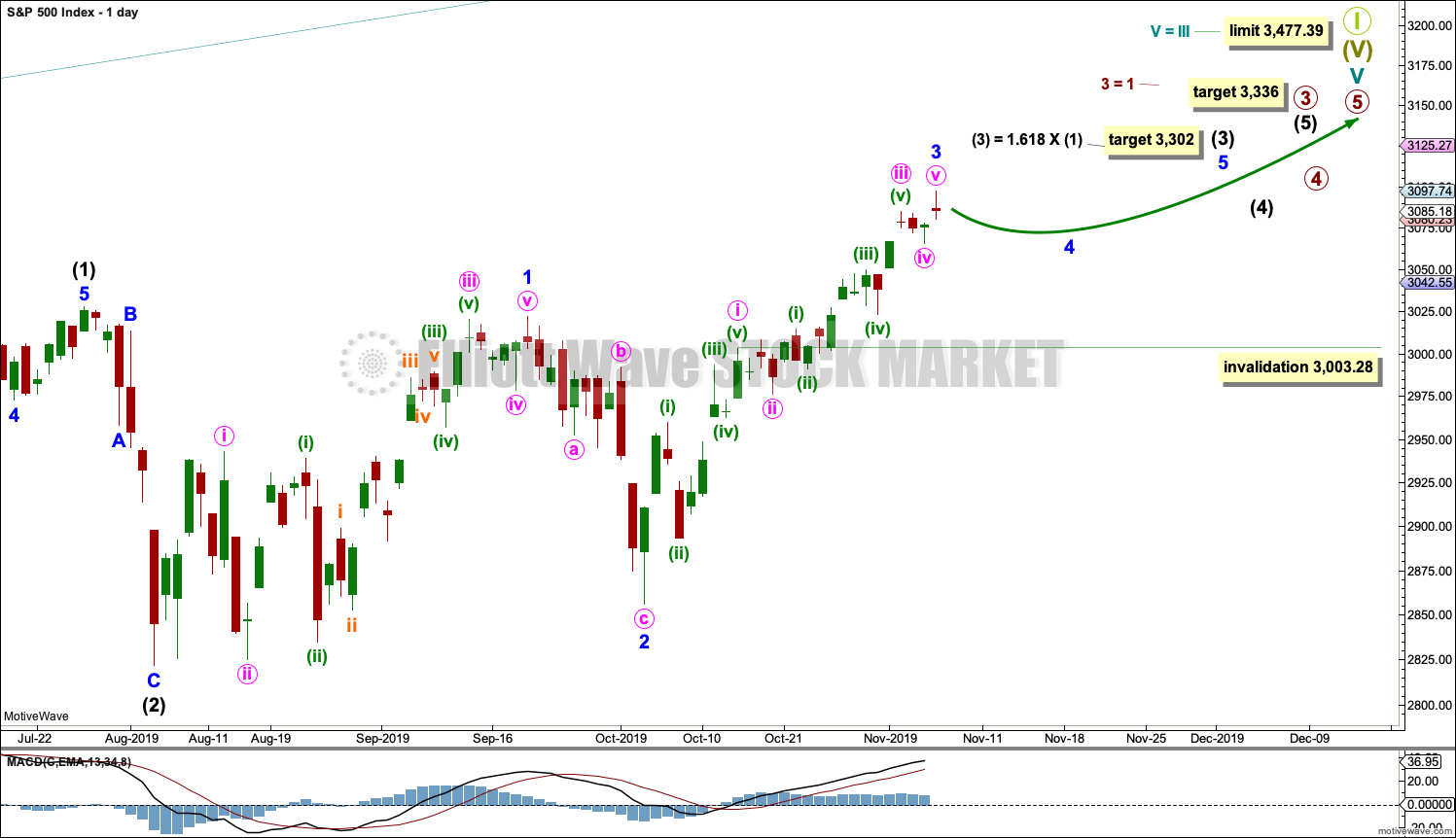
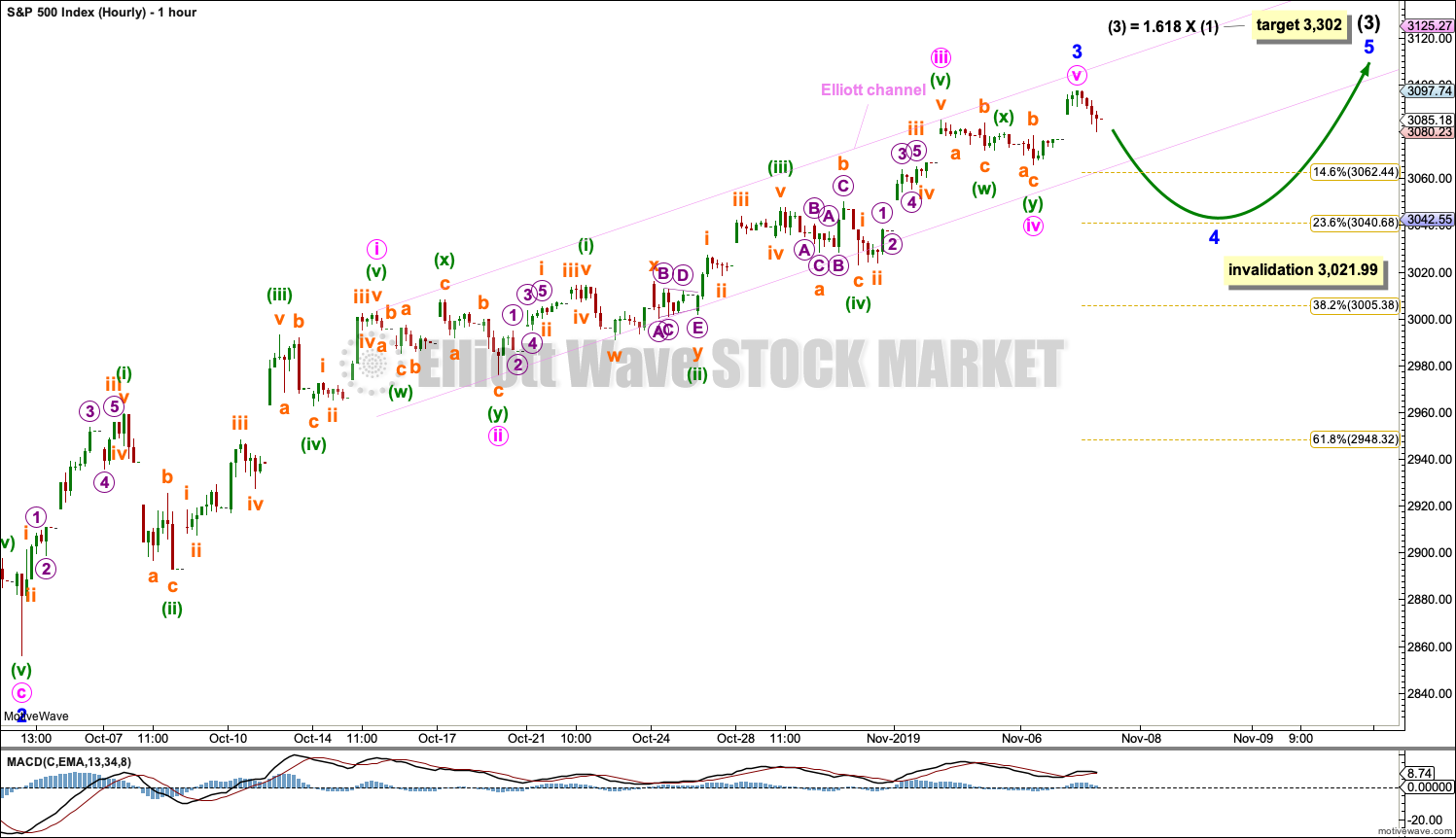

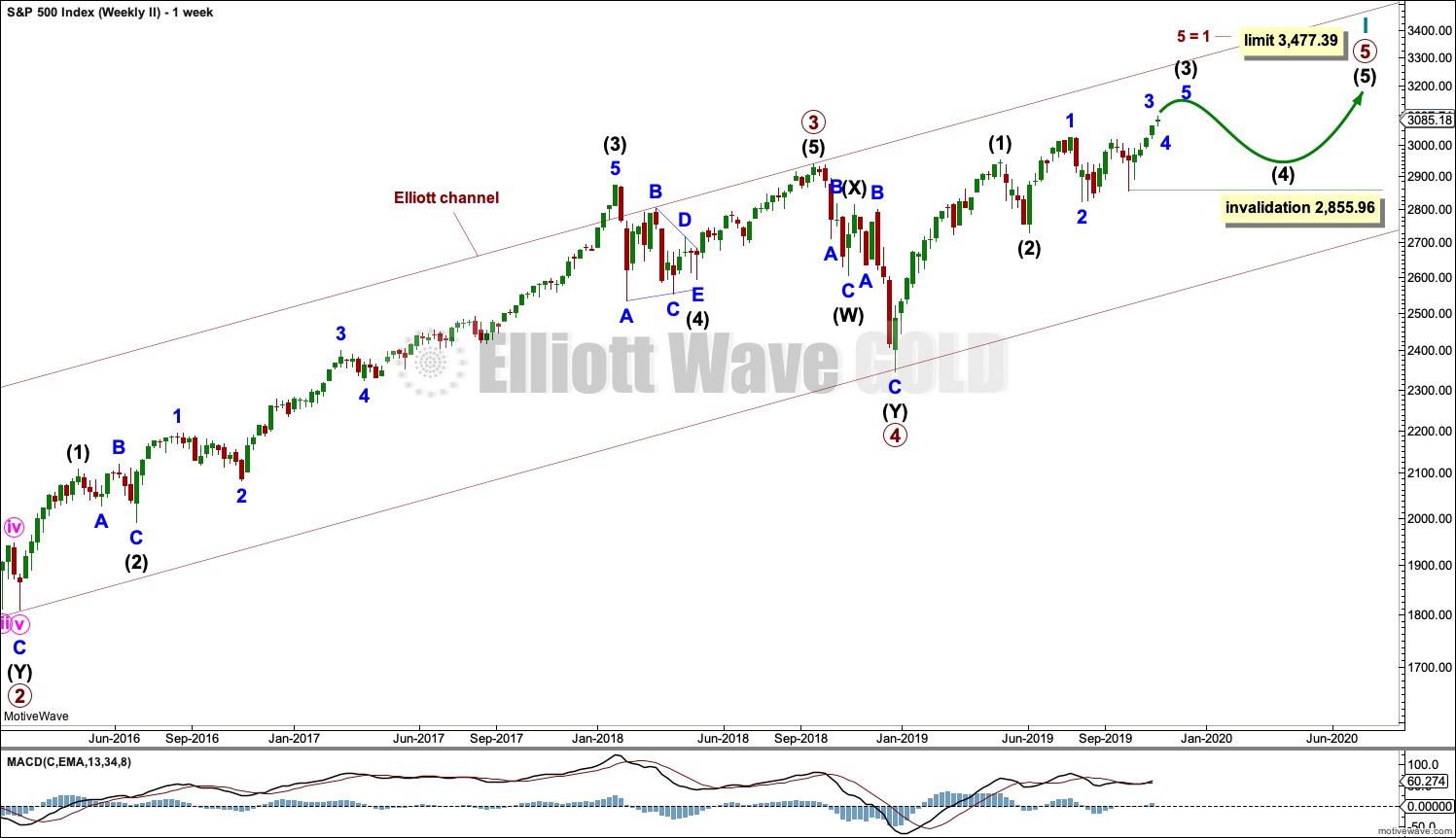
main hourly chart updated
hourly alternate updated
on the 5 min chart the move down today looks very much like a five wave impulse, so I don’t think the correction is over there
this is what I saw. probably off kilter somehow. even if possible, so many possibilities going forward. it does look like sideways/down for next few days in general.
Is there a strong reason you aren’t modeling the minute i at the 10/7 low? I think such a count “allows for” more upside price action here by making minute iii longer. Just curious.
sorry, the minute i at the 10/7 high and the minute ii at the 10/8 low?
From yesterday’s high on the SPX, there was 5 waves down to this morning’s low, and then 3 up.
(On the ES, it’s more a W, X and finishing B of Y).
SPX should fall to 3060s soon…
That looks very high potential, yes. Though I can also see the move down as an expanding flat with a biiiig C down. It counts well that way too. We’ll see!!
if the low so far for today is wave C of a flat, I’m struggling to see where the flat begins and where the end of A of an expanded flat was?
the last small swing low is at 3,065.89 on 6th November (minute iv on my main hourly chart) that’s where A of a flat could be IMO
so if today is C of an flat, it would be a running flat with a relatively big truncation
I strongly suspect this correction is over. Why? Because price dove down to the 2nd lower symmetric move level and turned up. That alone though isn’t the significant factor. What is significant to me is that both of the symmetric move depths achieved are on the “slow and low” corrective symmetric move lines, the ones that have less slope downward. The less slow in general, the smaller the overall corrective move (the deep corrections has a strong tendency to have high momentum/slope). So the slope of a move is highly informative. Based on that, I think the odds that this one is done is “more likely than not”, anyway. This is /ES 30 minute with overnight and the prior symmetric moves shown. The two tags now of successively deeper symmetric move end points are highlighted.
A little more supportive evidence: the SPX hourly shows that retrace hit and turned at a 76-78% Fibonacci zone. Perfect.
Hi Lara, Would you mind commenting on Bitcoin now that a move down into your blue 2 retrace level has begun? Thanks
I would love to see it as well. It looks to me like Minor 2 is underway with a target around 61.8% retrace or $8150 or so. As I said yesterday, EW traders / investors look to get in at the beginning of a 3rd wave of several degrees. Right now it looks like a Minor 3 of Intermediate 1 of Primary 3 of Cycle III. It seems like a very good entry point. I have some idle cash on the sidelines I would like to put to work.
Here’s a chart I updated yesterday. I can’t put todays candlestick on it because the session isn’t closed so final data isn’t available. But this session is a big fat red candlestick so far the low is at 8,846.93.
I’ve already bought some Bitcoin. I’ll put the final allocated $ into it today or tomorrow.
I’ve learned that when Bitcoin finds a low it moves very strongly up off that low. So trying to time a purchase at a low is difficult.
It may have a big upwards move on Monday. I want to buy before that.
Thanks so much. And thanks for you comment yesterday after the close answering Kevin’s and my questions. Have a great weekend.
#1.